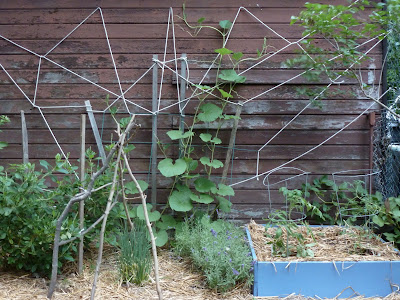The reason why I went to Garden in the Woods the other day was a workshop in tree planting, but I sort of got caught up in admiring the azaleas that were blooming and never posted anything from the workshop.
Our instructor was Rolph Briggs, a wellknown arborist with many projects under his belt. He is the man in the hat, as we are we are gathering around the pot-grown birch we have the honor of planting on the sacred grounds of the Wild flower Society.

I will not go into much detail about the workshop - it's actually pretty basic stuff. Unfortunately, trees today often get planted too deep which will eventually kill them, since the root system does not retrieve enough nutrition when it's buried under too much soil. This is partially because many people have the wrong idea of how trees grow their roots - we still tend to think they grow deep down, when they actually spread outwards and never really go any deeper than 6-18 inches. And it's partially a consequence of nursery machinery that digs up the young trees and wraps them in burlap for delivery to stores. The machine throws a lot of dirt on top of the root ball, and then the customer assumes the proper depth being the top of the burlap ball, when in fact the root flares should be clearly visible, and those extra inches of soil should be brushed off. He showed us how to remove soil from the trunk of the tree so that we could all see the first primary roots. If some of them were crossed, as roots will be if they've been confined to small pots for too long, the crossing roots need to be cut off so they won't be girdling the tree when the root keeps growing. This seems self evident - but there's still quite a lot of resistance and ignorance around the subject.
Here the primary roots of the tree are exposed and it can now be planted with the root flare clearly visible.
Once he hole was dug and the plant's roots were freed from the confining shape from its tim ein the container, the measuring stick came out. The tree was placed in the hole, and pretty much all of us was surprised to see that it really shouldn't go any deeper than this.
Again, we checked the depth with stick and a shovel.
and then we carefully filled up the hole with a gentle mix of compost and soil.
The special mulch came on
And although the tree was standing firm, we staked it for good measure.
Now, on the way home I couldn't help but notice how this new development has their trees planted deep and buried under vulcanoes of mulch.
If your trees look like this, please liberate them as soon as you can from the vulcano of mulch, and if it can't be replanted, at least don't bury it!





































